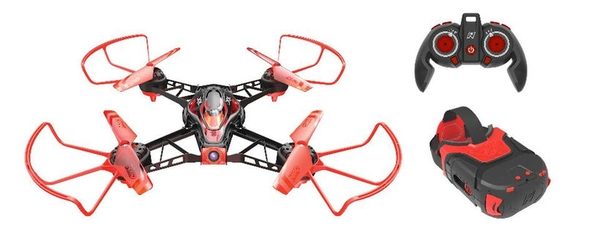
The Drone Racing League and Toy State have developed the Nikko Air line of racing drones powered by the same technology used by professional DRL pilots. The first models to come out of this partnership went on sale in August 2017. I had a chance to review one and experience the fast-paced fun of drone racing. Read on to see what I think!
What Is It?
Drone racing is an extreme sport in which pilots compete head-to-head with small flying drones while wearing first-person-view goggles. Like every type of competition, proficiency only comes with practice. The Nikko Air Race Vision 220 FPV Pro provides everything you need to start racing drones and practice the skills needed by a professional drone pilot. The kit includes real-time video transmission to a full color screen and FPV goggles that provide an immersive flight experience. Just in case, the drone is designed to be resistant to crashes. The controller has progressive flight modes and speed limiters that can be adjusted as skills improve akin to removing training wheels on a bicycle. The controller also has 4 buttons which are configured for one touch stunts. The drone can be connected to a computer to interface the controller to a DRL simulator on Steam or custom configured using BetaFlight.
Hardware Specs
- 220 mm wheelbase
- 5.8 GHz analog transmission
- 4.3″ LCD screen
- 130 degree wide angle camera with adjustable mount pitch
- Highly durable composite frame designed to flex, bend and crash
- 16 pre-programmed stunts
- Speeds of 25+ miles per hour
- removable propeller guards
- View and record stills and video from the drone POV
- BetaFlight controller tuning
- Hard case quick swap battery design
- Interchangeable pinch and thumb stick controls
- Does not require FAA registration
What’s in the box?
- Racing drone
- Controller + 4 AA batteries
- FPV goggles
- SD Card
- Screen Holder
- Thumb sticks
- 2 of 7.4 V Rechargeable Li-PO batteries
- USB charging cable
- 2 “A” and 2 “B” replacement propellers
- 4.3” LCD Screen + 4 AA batteries
- Instruction booklet
Design and Features
One of the stand out features of this kit is how complete it is.
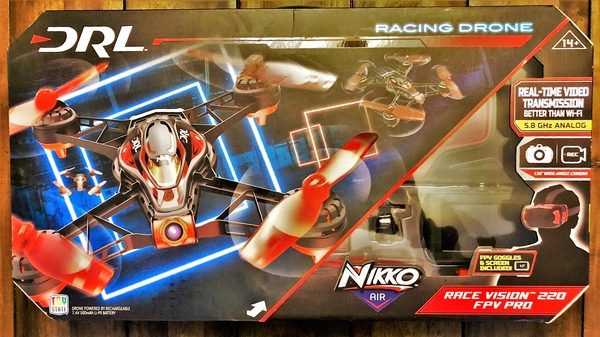
The package contains everything needed to start flying a few minutes after opening the tape on the box.
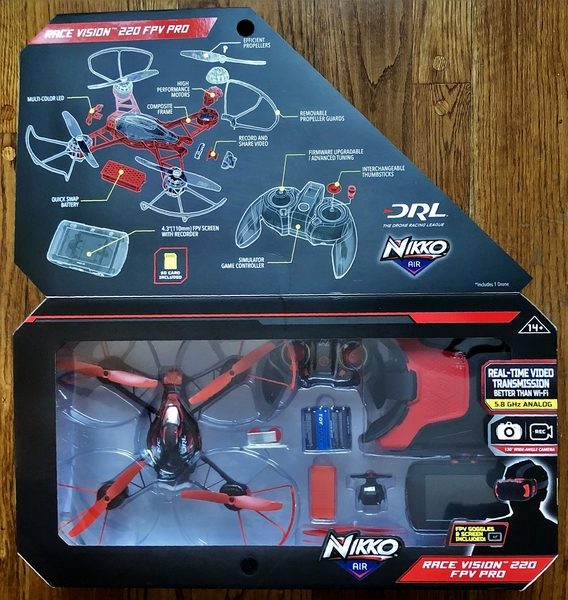
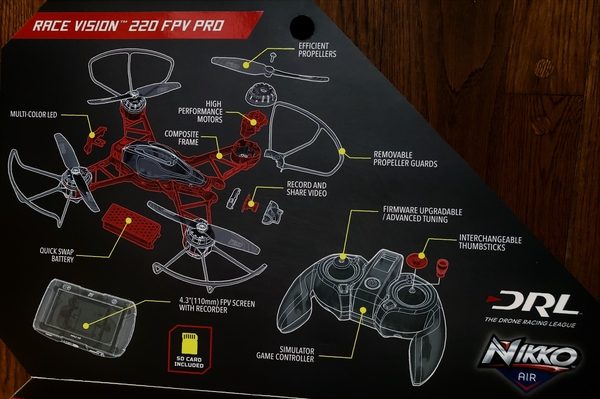
The package even includes batteries for the screen and the remote controller.
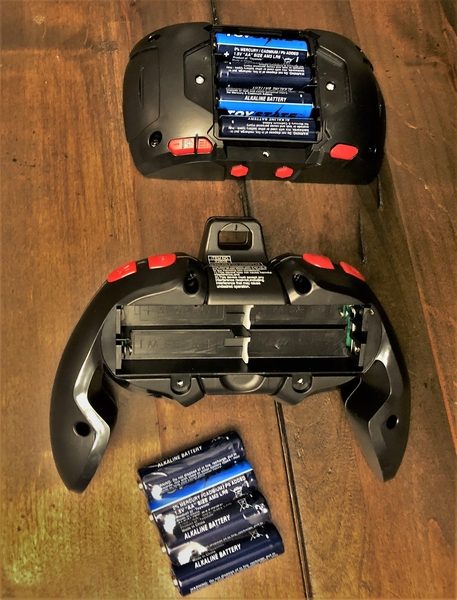
However, it seems that the batteries aren’t quite as fresh as they could be – the life indicator on the video display isn’t quite full even when used for the very first time.
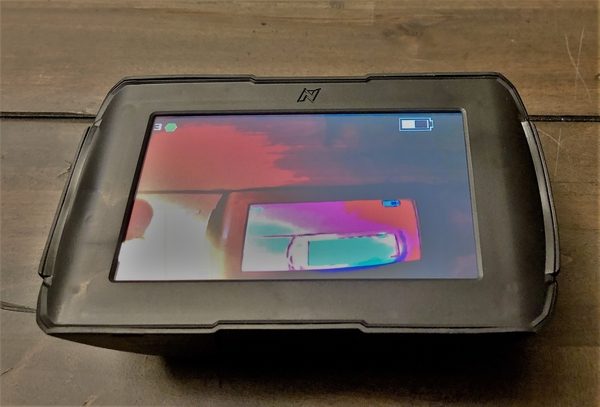
The drone is a 220 mm wheelbase design. A dollar is included in the picture for scale.
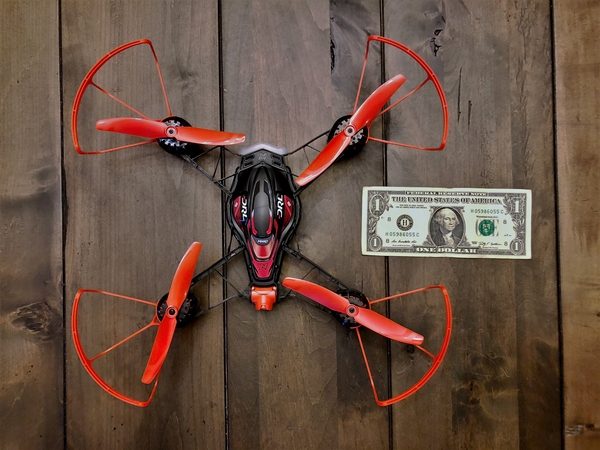
its a decent sized unit to learn how to pilot. One thing that is deceptive from the picture above is the type of motor installed on the drone. It looks like they are brushless type motors from a distance. But, upon closer inspection:
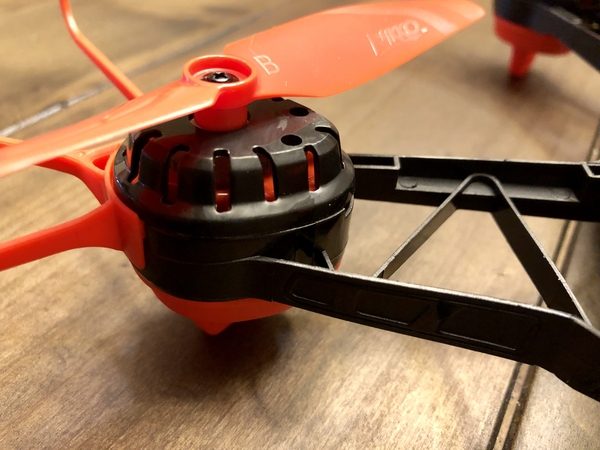
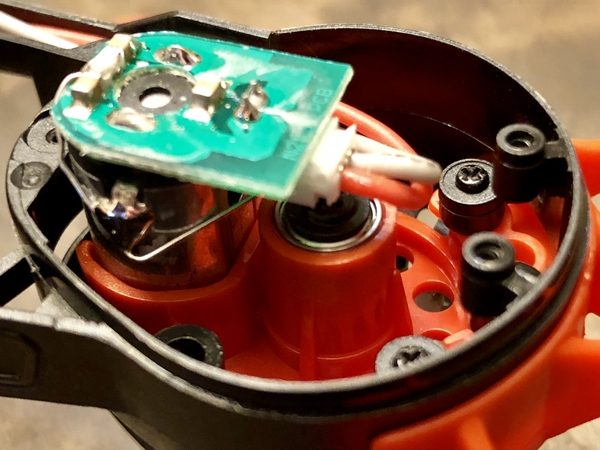
They are actually brushed gear motors. The drone still has plenty of pep, but an experienced pilot may complain about the responsiveness and top speed achievable.
The manual states that fully charging the battery will take from 60 to 180 minutes. Furthermore, the batteries may only be charged when installed in the drone. However, the batteries in the box were mostly charged.
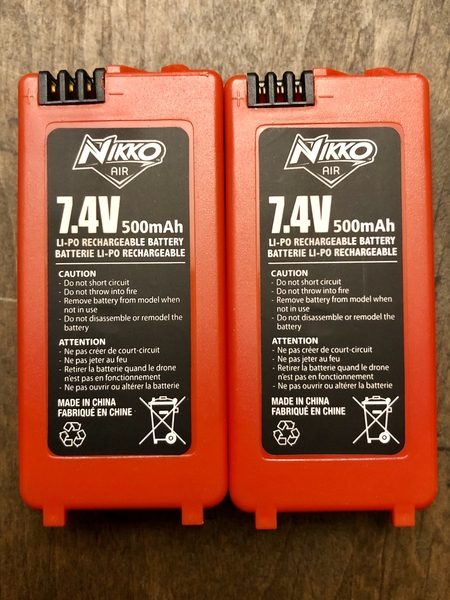
Its nice that the battery installation doesn’t require handling connectors. I tied the drone to a stool and ran the throttle close to 90% of capacity with a full battery. The battery lasted for 4:50 before the controller started to vibrate, alerting a low battery. The drone motors stopped 10 seconds later. This probably translates to the rated 6 minute flying time because rarely is the throttle turned up this much.
The controller is more like a game controller than a model aircraft controller, but that makes it easy to hold. I noticed that sometimes my yaw doesn’t center all the way back, but I usually have a finger on throttle anyway.
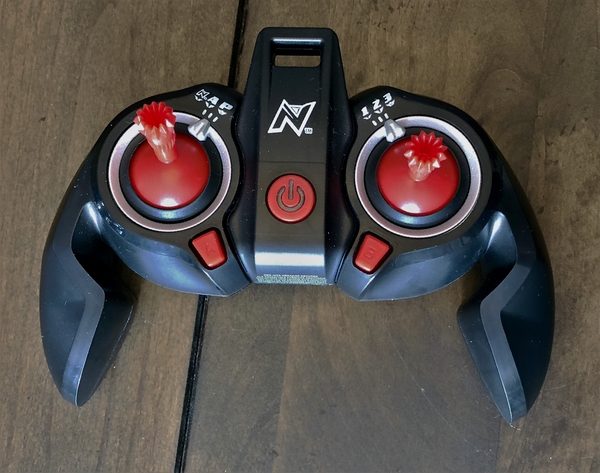
The buttons for tricks are easily reachable from the controller handles. The controller also has a vibration motor in it. It will vibrate when various settings and modes are made and will also vibrate to alert you that the drone battery is weak.
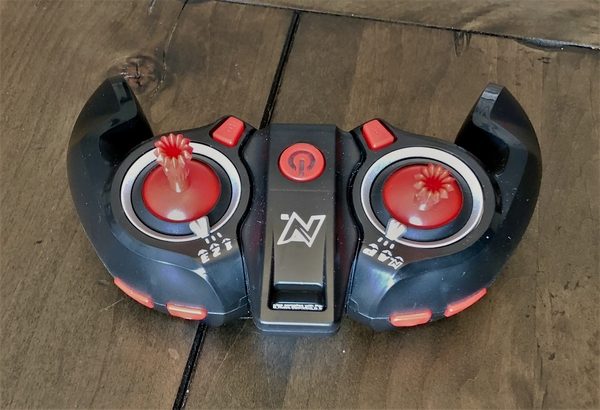
The controller has three built in modes: The Nikko mode has auto banking, the auto mode has auto leveling, and the pro mode has full acrobatic ability. The Nikko mode switches the yaw to the right stick and the roll to the left. The auto and pro modes have the same controller layout, with the throttle and yaw on the left and the pitch and roll on the right. It seems confusing that beginner lessons would be done in one mode and later lessons would be in another. Imagine, after driving for 6 months, that you learn the left pedal is really for breaking and the right is the accelerator. The controller also has two speed limiting settings: 1 is 50% max, 2 is 75% max and 3 permits 100% maximum speed.
Usually the first thing that is required when using a drone is trimming out the drift. The Race Vision is no exception, but the controller for this unit doesn’t have the usual trim wheels. Instead the pitch and roll stick is pushed in the direction opposite the drift. This is simple in theory but lacks the ability to specify the amount of trim applied. It may take a few repetitions to get it just right. Once it is trimmed out though the drone has a good ability to hover in one spot.
A pilot that can comfortably control the drone in P mode has the ability to adjust the responsiveness of the pitch, roll, and yaw by changing the PID tuning parameters in BetaFlight. Because the flight controller is BetaFlight compatible the flying experience can be tailored to personal preferences. Programming the drone is achieved by connecting it to a computer via a USB cable and then using the BetaFlight software in Chrome to adjust the settings.
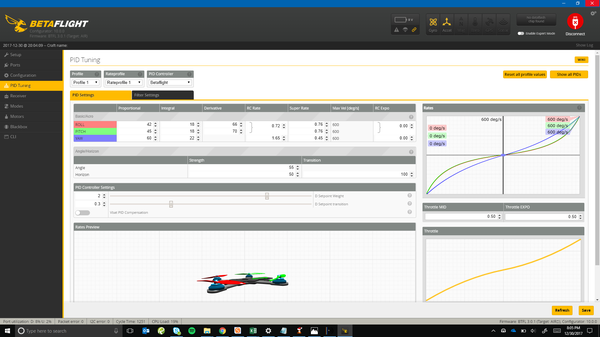
There are 16 stunts available by pressing bumper buttons in combination with the right stick. See the excerpt from the instruction manual below. The P mode has no auto-leveling so these stunts are possible by just using the sticks, but are also accessible by using the buttons.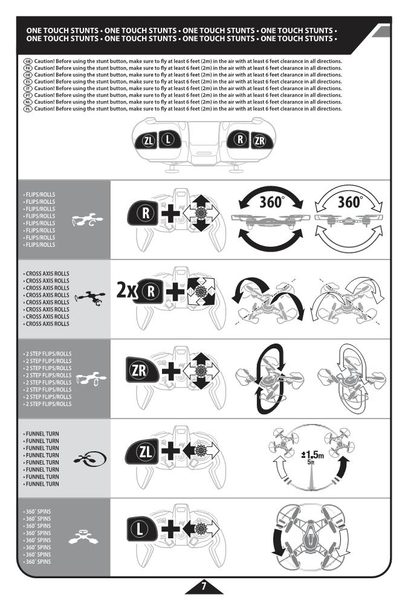
Rarely does the topic of learning to fly drones or drone stunts not include some discussion of crashes. The frame of the Race Vision drone is very robust and can take a beating. The nylon frame is designed to flex and adsorb the energy of a crash and ensures a damping of the impact. The propeller protectors limit damage to the propellers and other property during an impact and are removable for more advanced pilots.
The Race Vision 220 FPV comes with a 4.3″ LCD video screen. It is powered by 4 AA (included) batteries. The screen receives an analog 5.8Ghz signal which has the advantage of much less latency and greater range than WI-FI signal. The screen also has the capability of recording the incoming video. A 4GB Class 4 SD card is included with the set for this purpose. The recorded video is in .AVI format and has the following characteristics:
Bit rate : 6,711 kb/s
Width : 720 pixels
Height : 240 pixels
Frame rate : 60.000 FPS
The screen is also capable of recording still pictures with a resolution of 720 x 240 pixels.
The screen is designed to either be mounted on top of the controller or at the end of a head-mounted display.
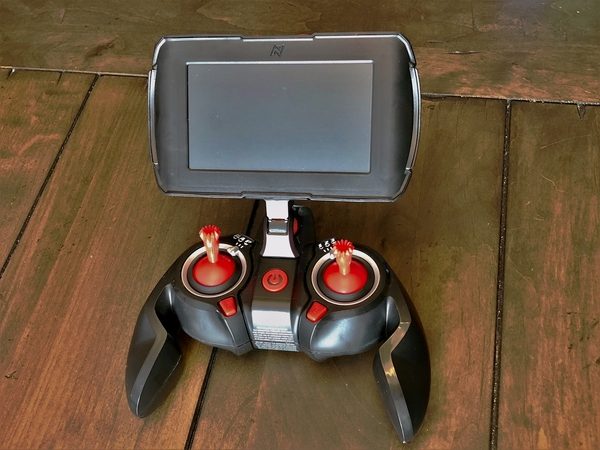 The image in the head mount display appears as a 48″ diagonal image at 3 feet distance. The image is neither stereoscopic nor convincingly immersive; the real benefit of the head-mounted design is that it allows training from a drone POV and completely isolated from observing the flight 3rd person.
The image in the head mount display appears as a 48″ diagonal image at 3 feet distance. The image is neither stereoscopic nor convincingly immersive; the real benefit of the head-mounted design is that it allows training from a drone POV and completely isolated from observing the flight 3rd person.
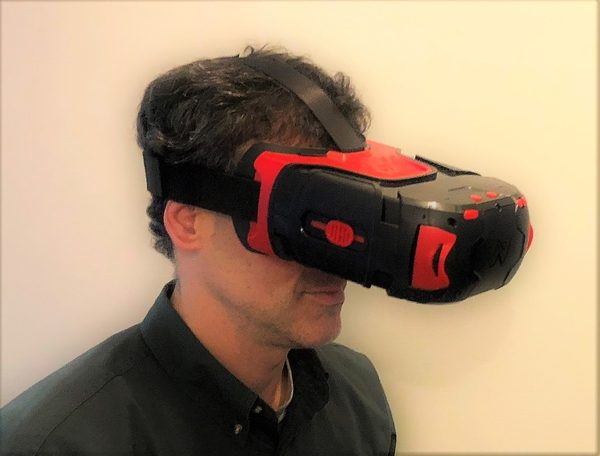
There are 3 basic ways to fly the drone: out in the open individually, out in the open with friends, or with the simulator. Using the drone individually is the most obvious scenario. I found that the range for the FPV was somewhat limited compared to other more professional units, but beat out what is typically provided by WI-FI drones. The video starts to cut out about 50 yards and when using the drone in a line-of-sight scenario. However, becasue the transmission is a linear 5.8 GHz signal (5732, 5769, 5806, or 5843 MHz) the FPV may be used with many other FPV goggles that support these frequencies. Also, the 130 degree FOV paired with the 240 TVL resolution made for difficult viewing at times.
One good thing about the camera on the drone is that it is also designed with growth in mind – the camera angle can be increased as the pitch is increased with faster flying speeds.
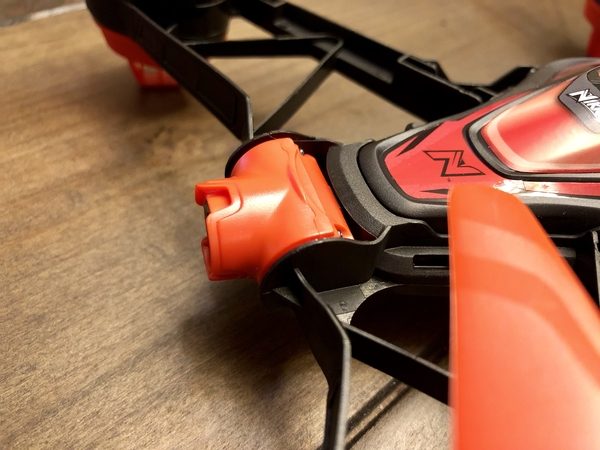
Each frequency has a different tail light LED color: green, cyan, blue, and violet. Unfortunately, the blue and cyan LEDs are virtually indistinguishable.
Using the drone with the simulator allows new pilots to learn how to fly a racing drone. The simulator allows pilots to practice the controls and perfect the basics before taking flight in real life. On the computer pilots can master skills, race against friends, and compete in actual DRL courses. The DRL simulator runs on the Steam game platform, which means it is cross-platform.
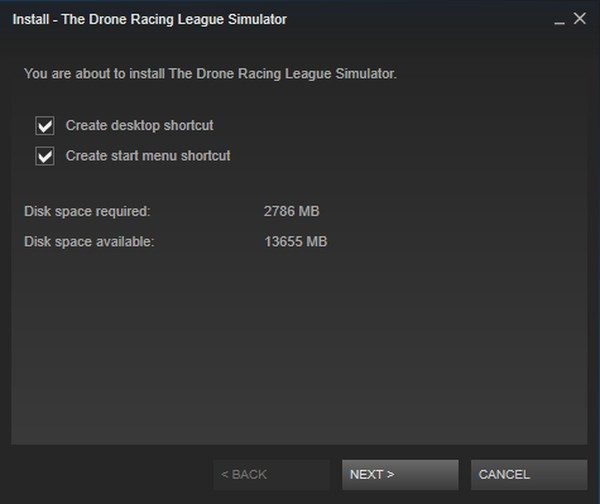 After installing Steam and the DRL simulator, the drone is USB connected to the computer and the controller can interact with the game just like it is being used in real life.
After installing Steam and the DRL simulator, the drone is USB connected to the computer and the controller can interact with the game just like it is being used in real life.
The image below is a screenshot from one of the training sessions
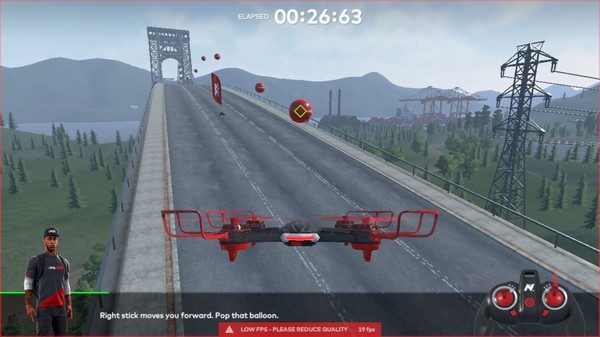
In the field I had a ball playing with this. I also crashed it a bunch of times too. The frame and propellers withstood all of my hard landings. The video I recorded has the quality of a bad VCR but looked better as I was filming.
Positives
- True novice to expert flexibility
- Complete kit includes everything (even batteries and an SD card!)
- BetaFlight compatible
- Simulator learning
- Durable design
Negatives
- Limited FPV range
- Limited controller range
- Marginal recorded video quality
Final thoughts
Having a drone controller and FPV goggles all in one package is nice. Its also great that the drone is designed for the novice through the enthusiast. I think the greatest benefit to this is the simulator. This is the perfect collection of merchandise and the right price point to get someone who is curious about drone racing into the sport. If you are looking for a system for a pilot that has intermediate experience, there are some comparably priced units on Amazon that don’t have simulator capability and may not have channel specific LEDs but have brushless motors, carbon fiber construction, 15 minute flight time, and HD video.
Price: $169.99
Where to buy: Target
Source: The sample of this product was provided by Nikko Air.



Gadgeteer Comment Policy - Please read before commenting
That’s how you write a review, thanks for sharing such a detailed review. Keep it up.
Great review. Since I’ve had zero success with nikko maybe you could help me. My 220 racing drone got some grass around a propeller leaving The motor dead. Possibly burnt. But I cannot find replacements anywhere. Any suggestions?
Jamie, Sorry to hear about your drone. Try this:
NIKKO Repair Policy:
Please contact our Breda office for information regarding repair of NIKKO products.
Toy State Europe B.V.
Moskesbaan 8
4823 AH Breda
The Netherlands
http://www.nikkorc.com/contact